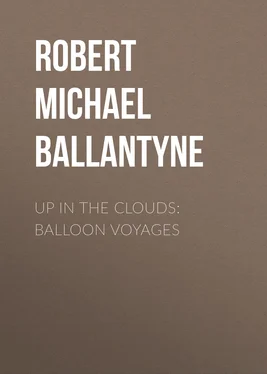Robert Michael Ballantyne - Up in the Clouds - Balloon Voyages
Здесь есть возможность читать онлайн «Robert Michael Ballantyne - Up in the Clouds - Balloon Voyages» — ознакомительный отрывок электронной книги совершенно бесплатно, а после прочтения отрывка купить полную версию. В некоторых случаях можно слушать аудио, скачать через торрент в формате fb2 и присутствует краткое содержание. Жанр: Детские приключения, literature_19, foreign_antique, foreign_prose, foreign_children, на английском языке. Описание произведения, (предисловие) а так же отзывы посетителей доступны на портале библиотеки ЛибКат.
- Название:Up in the Clouds: Balloon Voyages
- Автор:
- Жанр:
- Год:неизвестен
- ISBN:нет данных
- Рейтинг книги:5 / 5. Голосов: 1
-
Избранное:Добавить в избранное
- Отзывы:
-
Ваша оценка:
- 100
- 1
- 2
- 3
- 4
- 5
Up in the Clouds: Balloon Voyages: краткое содержание, описание и аннотация
Предлагаем к чтению аннотацию, описание, краткое содержание или предисловие (зависит от того, что написал сам автор книги «Up in the Clouds: Balloon Voyages»). Если вы не нашли необходимую информацию о книге — напишите в комментариях, мы постараемся отыскать её.
Up in the Clouds: Balloon Voyages — читать онлайн ознакомительный отрывок
Ниже представлен текст книги, разбитый по страницам. Система сохранения места последней прочитанной страницы, позволяет с удобством читать онлайн бесплатно книгу «Up in the Clouds: Balloon Voyages», без необходимости каждый раз заново искать на чём Вы остановились. Поставьте закладку, и сможете в любой момент перейти на страницу, на которой закончили чтение.
Интервал:
Закладка:
R. M. Ballantyne
Up in the Clouds: Balloon Voyages
Chapter One.
Balloon Voyages. Treats of Early Efforts to Fly, etcetera
It is man’s nature to soar intellectually, and it seems to have been his ambition from earliest ages to soar physically.
Every one in health knows, or at some period of life must have known, that upward bounding of the spirit which induces a longing for the possession of wings, that the material body might be wafted upwards into those blue realms of light, which are so attractive to the eye and imagination of poor creeping man that he has appropriately styled them the heavens.
Man has envied the birds since the world began. Who has not watched, with something more than admiration, the easy gyrations of the sea-mew, and listened, with something more than delight, to the song of the soaring lark?
To fly with the body as well as with the mind, is a wish so universal that the benignant Creator Himself seems to recognise it in that most attractive passage in Holy Writ, wherein it is said that believers shall “mount up with wings as eagles, they shall run and not be weary, they shall walk and not faint.”
Of course man has not reached the middle of the nineteenth century without making numerous attempts to fly bodily up to the skies. Fortunately, however, such ambitious efforts have seldom been made except by the intellectually enthusiastic. Prosaic man, except in the case of the Tower of Babel, has remained content to gaze upwards with longing desire, and only a few of our species in the course of centuries have possessed temerity enough to make the deliberate effort to ride upon the wings of the wind.
Naturally, the first attempts were, like most beginnings, simple and imitative. The birds flew with wings, therefore man put on artificial wings and essayed to fly like the birds. It was not until many grievous disappointments and sad accidents had befallen him, that he unwillingly gave up wings in despair, and set to work to accomplish his ends by more cumbrous and complex machinery.
Very early in the world’s history, however, “flying machines” were made, some of which were doubtless intended by their honest inventors to carry men through the air, while others were mere shams, made by designing men, wherewith to impose upon the ignorant for wicked ends of their own; and some of these last were, no doubt, believed to be capable of the feats attributed to them.
The credulity of the ancients is not to be wondered at when we reflect on the magical illusions which science enables us to produce at the present day—illusions so vivid and startling that it requires the most elaborate explanations by adepts and philosophers to convince some among their audiences that what they think they see is absolutely not real! No wonder that the men of old had firm faith in the existence of all kinds of flying machines and creatures.
They believed that fiery dragons were created by infernal machination, which, although not what we may call natural creatures, were nevertheless supposed to rush impetuous through the sky, vomiting flames and scattering the seeds of pestilence far and wide. In those dark ages, writers even ventured to describe the method of imitating the composition of such terrific monsters! A number of large hollow reeds were to be bound together, then sheathed completely in skin, and smeared over with pitch and other inflammable matters. This light and bulky engine, when set on fire, launched during thick darkness from some cliff into the air, and borne along by the force of the wind, would undoubtedly carry conviction to the minds of the populace, whilst it would fill them with amazement and terror!
Sometimes, however, those who attempted to practise on the credulity of their fellows were themselves appalled by the results of their contrivances. Such was the case so late as the year 1750, when a small Roman Catholic town in Swabia was almost entirely burnt to ashes by an unsuccessful experiment made by some of the lowest order of priests for the astonishment, if not the edification, of their flocks. An attempt was made by them to represent the effigy of Martin Luther, whom the monks believed to be in league with Satan, under the form of a winged serpent with a forked tail and hideous claws. Unfortunately Martin’s effigy, when ignited, refused to fly, and, instead of doing what was required of it, fell against the chimney of a house to which it set fire. The flames spread furiously in every direction, and were not subdued until the town was nearly consumed.
In the early part of the sixteenth century a very determined attempt at flying was made by an Italian who visited Scotland, and was patronised by James the Fourth. He gained the favour of that monarch by holding out to him hopes of replenishing his treasury by means of the “philosopher’s stone.” The wily Italian managed, by his plausible address, to obtain a position which replenished, to some degree, his own empty purse, having been collated by royal favour to the abbacy of Tungland, in Galloway. Being an ingenious fellow, and somewhat, apparently, of an enthusiast, he spent some of his leisure time in fashioning a pair of huge wings of various plumage, with which he actually undertook to fly through the air from the walls of Stirling Castle to France! That he believed himself to be capable of doing so seems probable, from the fact that he actually made the attempt, but fell to the ground with such violence as to break his leg. He was sharp-witted, however, for instead of retiring crest-fallen at his failure, he coolly accounted for the accident by saying, “My wings were composed of various feathers; among them were the feathers of dunghill fowls, and they, by a certain sympathy, were attracted to the dunghill; whereas, had my wings been composed of eagles’ feathers alone, the same sympathy would have attracted them to the region of the air!”
About a century later a poor monk, whose boldness and enterprise were more conspicuous than his prudence, attempted a similar feat. He provided himself with a gigantic pair of wings, constructed on a principle propounded by the rector of the grammar school of Tubingen, in 1617, and, leaping from the top of a high tower, fell to the ground, broke both his legs, and lost his life.
It was long before men came to see and admit that in regard to this they were attempting to accomplish the impossible.
There can be no doubt that it is absolutely impossible for man to fly by the simple power of his own muscles, applied to any sort of machinery whatever. This is not an open question. That man may yet contrive to raise himself in the air by means of steam or electricity, or some other motive power, remains to be seen. It does not seem probable, but no one can say authoritatively that it is impossible. It is demonstrable, however, that to rise, or even to remain suspended, in the air by means of machinery impelled by human force alone is a feat which is as much an impossibility as it is for a man, by the strength of his own legs, to leap thirty or forty times his own length,—a grasshopper can do that easily, and a bird can fly easily, but a man cannot, and never will be able to do so, because his peculiar conformation forbids it.
This was first demonstrated by Borelli, an eminent Italian mathematician and philosopher, who lived in a fertile age of discovery, and was thoroughly acquainted with the true principles of mechanics and pneumatics. He showed, by accurate calculation, the prodigious force which in birds must be exerted and maintained by the pectoral muscles with which the all-wise Creator has supplied them, and, by applying the same principles to the structure of the human frame, he proved how extremely disproportionate was the strength of the corresponding muscles in man. In fact, the man who should attempt to fly like a bird would be guilty of greater folly and ignorant presumption than the little infant who should endeavour to perform the feats of a gladiator! It is well for man in all things to attain, if possible, to a knowledge of what certainly lies beyond his powers, for such knowledge prevents the waste and misdirection of energies, as well as saving from disappointment and other evil results.
Читать дальшеИнтервал:
Закладка:
Похожие книги на «Up in the Clouds: Balloon Voyages»
Представляем Вашему вниманию похожие книги на «Up in the Clouds: Balloon Voyages» списком для выбора. Мы отобрали схожую по названию и смыслу литературу в надежде предоставить читателям больше вариантов отыскать новые, интересные, ещё непрочитанные произведения.
Обсуждение, отзывы о книге «Up in the Clouds: Balloon Voyages» и просто собственные мнения читателей. Оставьте ваши комментарии, напишите, что Вы думаете о произведении, его смысле или главных героях. Укажите что конкретно понравилось, а что нет, и почему Вы так считаете.












